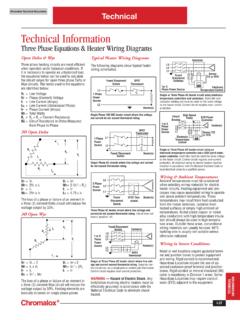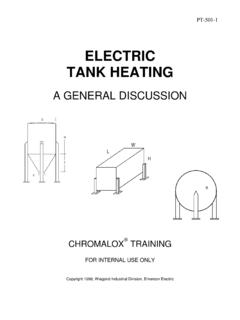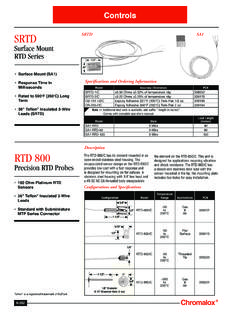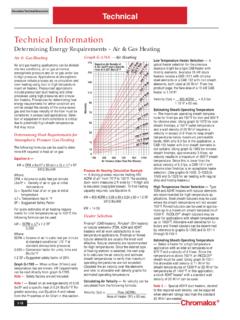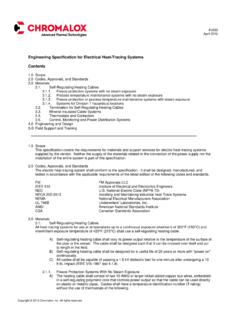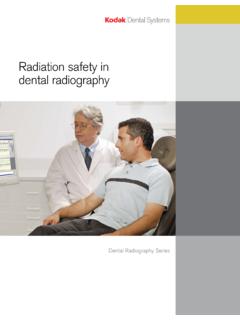Transcription of HEAT TRACING PRODUCTS - Chromalox, Inc.
1 HEAT TRACINGPRODUCTST raining ManualCHROMALOX TRAININGFOR INTERNAL USE ONLYC opyright 1998, E. L. Wiegand Div. Emerson ElectricPJ-324 Written ByAdam Heiligenstein& Gary OzegovichChromalox IndustrialE. L. Wiegand Electric Alpha , PA 15238(412) 967-3800 Trademarks:NFPA and NEC are registered trademarks of National Fire Protection AssociationUL is a trademark of Underwriter Laboratories, is a trademark of Factory Mutual Research CorporationCSA is a registered trademark of Canadian Standards AssociationIEEE is a registered trademark of The Institute of Electrical and Electronics Engineers, 3/98 The facts and the recommendations made in thispublication are based on our own research and theresearch of others and are believed to be cannot anticipate all conditions under which thisinformation and our PRODUCTS or the PRODUCTS of othermanufacturers in combination with our PRODUCTS maybe used.
2 We accept no responsibility for resultsobtained by the application of this information or thesafety and suitability of our PRODUCTS either alone or incombination with other PRODUCTS . Users are advisedto make their own tests to determine the safety andsuitability of each such product or productcombination for their own of ContentsChapter 1 Heating Fundamentals..1 Chapter 2 Heating Cable PRODUCTS ..10 Chapter 3 Heating Cable Designs..20 Chapter 4 Circuit Layout and Controls..29 Chapter 5 Hazardous Area Considerations ..45 Chapter 6 Miscellaneous, But Important Topics.. 51 AppendixSolutions to Sample Problems..A-1 TablesTable 1 Insulation k-Factors ..9 Table 2 Nominal Constant Wattage Cable Outputs on Alternate Voltages14 Table 3 Heating Cable product Comparison.
3 18 Table 4 Heat Loss for Pipes ..21 Table 5 Insulation k-Factors ..21 Table 6 Pipe Equipment Allowances ..22 Table 7 Heat Loss for Tanks..24 Table 8 Tank Equipment Heat Loss ..24 Table 9 Overhang Cable Requirements ..27 Table 10T-Class Ratings..45 Table 11 Typical U-Values..46 Table 12 Output Curve Formulas for Self Regulating Cable..53 GraphsGraph 1 Primary verses Supplemental Heating..7 Graph 2 Typical Low Temperature .. 16 Graph 3 Typical Medium Temperature Self Regulating Cable Output Curves .16 Graph 4 Maximum Maintenance and Exposure Temperatures..19 Graph 5 Low Temperature Self Regulating Cable Without Aluminum Tape ..51 Graph 6 Low Temperature Self Regulating Cable With Aluminum Tape..51 THIS PAGE INTENTIONALLY LEFT BLANKHEAT TRACING product - Training Manual CHROMALOX TRAININGC hapter 1: Heating Fundamentals Before plunging headfirst into a myriad of heat trace designs, PRODUCTS and applications,one must first have an understanding of the basics of heat loss and why heat traceproducts are used.
4 This section deals with the basic principles of heat transfer and thecalculations used for pipes and vessels. It has been left as a review of general thermalconcepts and is not intended to be a detailed discussion of 1 depicts a sectional view of a typical pipe system. It consists of the pipe,insulation, a weather barrier and gaps between each layer. If the pipe and its contentsare warmer than the surrounding environment,heat will be transferred from the pipe to the air. Ifenough heat is transferred out of the pipe, thepipe contents may thicken or solidify resulting indamage to pipes or pumping equipment. Thefollowing sections address fundamental heattransfer concepts used to arrive at a generalformula that is used in heat loss Illustrations 2 and 3.
5 Two water buckets are joined by a pipe. In Illustration 2,the valve is closed and the right bucket is empty. When the valve is opened, water flowsthrough the valve and into the right bucket as shown in Illustration 3. The two bucketswill attain an equal amount of water in flows from one object to another in much thesame way as water. Objects of unequaltemperatures in a thermal system tend towardthermal equilibrium. The hotter object transferssome of its heat to the colder object until theobjects are the same can be transferred by way of conduction,convection and radiation . Of the three methods oftransferring heat, conduction is considered to bethe most efficient 1 Illustration 3 Illustration 2 CHROMALOX HEAT TRACING product - Training ManualTRAININGC hapter 1 Page 2 Copyright 1997, W iegand Industrial Division, Emerson Electric Conduction is defined as transferring heat or electricity through aconducting medium by way of direct contact.
6 The rate of heat transfer is dependentupon how much resistance exists between objects of differing temperatures. In manycases the transfer of heat from one medium to another is desired. Cooking is aneveryday example of intended heat transfer. Also, most electronic components operatemore efficiently if excess heat generated by the equipment is dissipated to a mediumnot adversely affected by the addition of heat. In contrast, preserving heat in a systemcan be just as important as heat transfer. Keeping a pipes contents above freezing incold weather is a common practice of minimizing heat a substance acts as a thermal conductor or insulator depends on the thermalresistive properties of the substance. Thermal resistance, R, is a measure of anobjects ability to retard heat transfer by way of conduction through a given thickness ofthe substance.
7 Mathematically, R is:Eq. = L/k, where:L = insulation thickness, inchesk = thermal conductivity, (BTU)(in)/(ft2)(oF)(hr)As the thickness L changes, it affects the R value, orthermal resistance of an insulation. K values areconstants which are specific to the physicalproperties of a given material. They measure amaterials ability to transfer better understand the pipe model inIllustration 1, consider illustrations 4 and5 of theoretically equivalent, perfectly flatsteel surfaces. In Illustration 4 thesurfaces are in direct contact; inIllustration 5 they are separated by amaterial that has physical propertiesdifferent from the two steel surfaces. Inboth cases, assume the initial states ofsurface A are 70oF and surface B are 0oFand there are no air gaps between rate at which heat will be transferredto the cooler surfaces is affected by the amount of resistance between the surfaces A and Illustration 4, there is no resistance between the two surfaces - heat can be directly transferred fromsurface A to B.
8 However, the substance sandwiched between surfaces A and B in Illustration 5 mayaffect the rate at which heat can be transferred. If the physical properties of the material allow for rapidheat transfer, the two surfaces will reach thermal equilibrium quickly. If the material restricts the transferof heat, or acts as an insulator, the length of time to reach thermal equilibrium will be Common K Values (at room temperature)Steel 4 Illustration 5 ELECTRIC HEATING CABLE- Training Manual CHROMALOX TRAININGPage 3 Chapter 1 Copyright 1997, W iegand Industrial Division, Emerson Electric Losses by convection can be seen to be negligible in a system withoutextensive calculations. In example , we disregarded convection losses by assumingno air gaps between any surface.
9 In actuality, small air gaps exist between the surfacewall and insulation. The air gaps are normally slight, less than 1/10th of an inch, andprevent the flow of air which restricts convection. Although small air gaps do not affectheat loss via convection, their thermal resistive properties should be analyzed todetermine the contribution to system heat loss through conduction. Using Equation ,consider the Illustration 1 consists of 1 fiberglass insulation and the air gap between thepipe wall and insulation is inch. Using Equation , we can calculate theresistance of the insulation and air gap. A ratio of the two resistances indicates thatinsulation has the greatest impact in overall thermal resistance and minor imperfectionsin applying insulation are = L/kR (fiberglass) = (1) = ( )R (air gap) = ( ) = ( )R (total) = R (fiberglass) + R (air gap) = + = of resistance due to air gap = Radiant heat loss occurs as a result of highly energized moleculestransmitting heat by way of waves or particles.
10 For significant heat loss to occur fromradiation, the hotter surface must be well above ambient temperature - much higherthan what is observed in typical heat trace applications. Therefore, heat loss fromradiation can be practical, low to medium temperature applications, convection andradiation account for about 10% of the overall heat loss of a system. Byadding 10%, the general formula for calculating the heat loss of a systemvia conduction, convection and radiation can be HEAT TRACING product - Training ManualTRAININGC hapter 1 Page 4 Copyright 1997, W iegand Industrial Division, Emerson Electric Surface Heat Loss Calculations. Theterminology heat loss commonly refers to the heattransfer of an object to its ambient implies that the object in question, a wall inIllustration 6 for example, is at a temperature abovethe ambient temperature.

